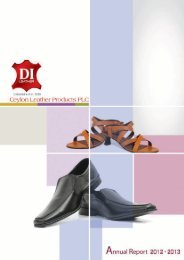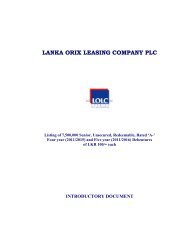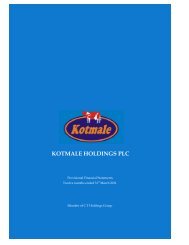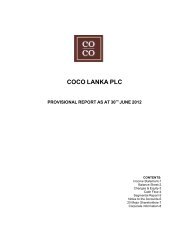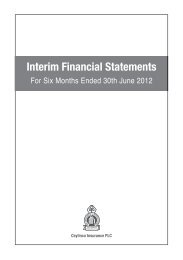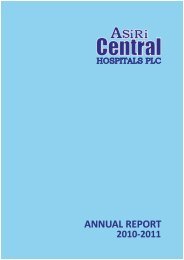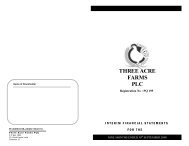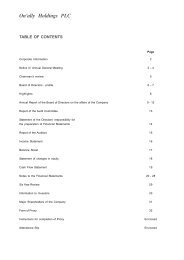Annual Report 2010-2011 - Colombo Stock Exchange
Annual Report 2010-2011 - Colombo Stock Exchange
Annual Report 2010-2011 - Colombo Stock Exchange
You also want an ePaper? Increase the reach of your titles
YUMPU automatically turns print PDFs into web optimized ePapers that Google loves.
financial year are discussed below. The respective carrying<br />
amounts of assets and liabilities are given in related notes to<br />
the financial statements.<br />
Defined benefit plans<br />
The cost of defined benefit plans- gratuity is determined using<br />
actuarial valuations. The actuarial valuation involves making<br />
assumptions about discount rates, expected rates of return<br />
on assets, future salary increases, mortality rates and future<br />
pension increases. Due to the long term nature of these plans,<br />
such estimates are subject to significant uncertainty. Further<br />
details are given in Note 17.<br />
Intangible assets<br />
For the purposes of impairment testing, goodwill is allocated<br />
to cash generating units when cash generating units to which<br />
goodwill has been allocated are tested for impairment annually,<br />
using Value in Use method. The calculation of value in use for<br />
the cash generating unit is most sensitive to the assumptions of<br />
sales growth, discount rates and cost increases due to inflation.<br />
Further details are given in Note 4.<br />
Inventory valuation - Produce inventory<br />
The Group has valued part of unsold produce inventory at<br />
since realized prices. The balance unsold inventory remained<br />
as at the balance sheet date valued at an estimated selling<br />
price based on most recent selling prices available subsequent<br />
to the year end.<br />
2.2 FOREIGN CURRENCY TRANSLATION<br />
2.2.1 Foreign currency transactions<br />
The consolidated financial statements are presented in<br />
Sri Lanka rupees, which is the company’s functional and<br />
presentation currency.<br />
The functional currency is the currency of the primary<br />
economic environment in which the entities of the group<br />
operate.<br />
All foreign exchange transactions are converted to Sri Lanka<br />
rupees, at the rates of exchange prevailing at the time the<br />
transactions are effected.<br />
Monetary assets and liabilities denominated in foreign currency<br />
are retranslated to Sri Lanka rupee equivalents at the exchange<br />
rate prevailing at the Balance Sheet date. Non-monetary assets<br />
and liabilities are translated using exchange rates that existed<br />
when the values were determined. The resulting gains and<br />
losses are accounted for in the Income Statement.<br />
2.2.2 Foreign operations<br />
The Balance Sheet and Income Statement of subsidiaries<br />
which are deemed to be foreign operations are translated<br />
to Sri Lanka rupees at the rate of exchange prevailing as at<br />
the Balance Sheet date and at the average annual rate of<br />
exchange for the period respectively.<br />
Arpitalian Compact Soles (Private) Limited use US dollars<br />
as its functional currency as it conducts the majority of its<br />
business in US dollars and is entitled to the benefits provided to<br />
companies approved by the Board of Investment of Sri Lanka.<br />
Arpitalian Compact Soles (Private) Limited adopted US dollars<br />
as its measurement and functional currency in line with SLAS<br />
21 which deals with “Effects of Changes in Foreign <strong>Exchange</strong><br />
Rates” and has been translated to the presentation currency of<br />
the group, Sri Lankan Rupees, for consolidation purpose.<br />
The exchange differences arising on the translation are taken<br />
directly to a separate component of equity. On disposal of a<br />
foreign entity, the deferred cumulative amount recognized in<br />
equity relating to that particular foreign operation is recognized<br />
in the Income Statement.<br />
2.3 TAX<br />
2.3.1 Current tax<br />
Provision for income tax is based on the elements of income<br />
and expenditure as reported in the financial statements and is<br />
computed in accordance with the provisions of the relevant tax<br />
statutes.<br />
2.3.2 Deferred tax<br />
Deferred taxation is the tax attributable to the temporary<br />
differences that arise when taxation authorities recognize and<br />
measure assets and liabilities with rules, that differ from those<br />
of the consolidated financial statements.<br />
Deferred tax is provided using the liability method on temporary<br />
differences at the balance sheet date between the tax bases<br />
of assets and liabilities and their carrying amounts for financial<br />
reporting purposes.<br />
Deferred tax assets are recognized for all deductible temporary<br />
differences, carry-forward of unused tax credits and unused tax<br />
losses, to the extent that it is probable that taxable profit will be<br />
available against which the deductible temporary differences,<br />
and the carry-forward of unused tax credits and unused tax<br />
losses can be utilized.<br />
The carrying amount of deferred tax assets is reviewed at<br />
each Balance Sheet date and reduced to the extent that it is<br />
no longer probable that sufficient taxable profit will be available<br />
to allow all or part of the deferred tax asset to be utilized.<br />
Unrecognized deferred tax assets are reassessed at each<br />
balance sheet date and are recognized to the extent that it<br />
has become probable that future taxable profit will allow the<br />
deferred tax asset to be recovered.<br />
69<br />
<strong>Annual</strong> <strong>Report</strong> <strong>2010</strong>/<strong>2011</strong> | Richard Pieris and Company PLC





